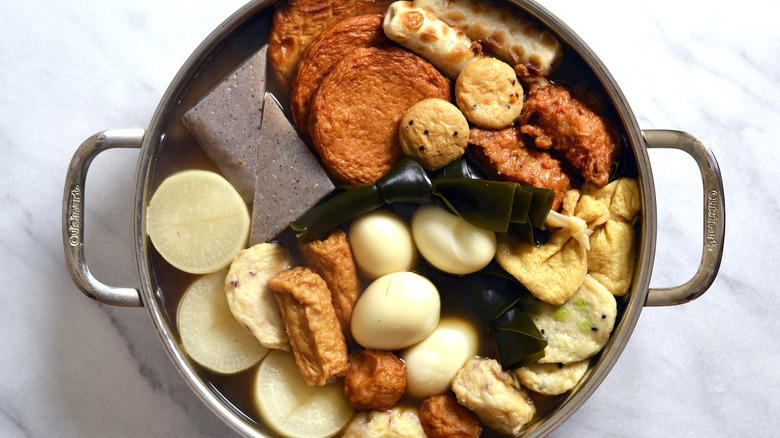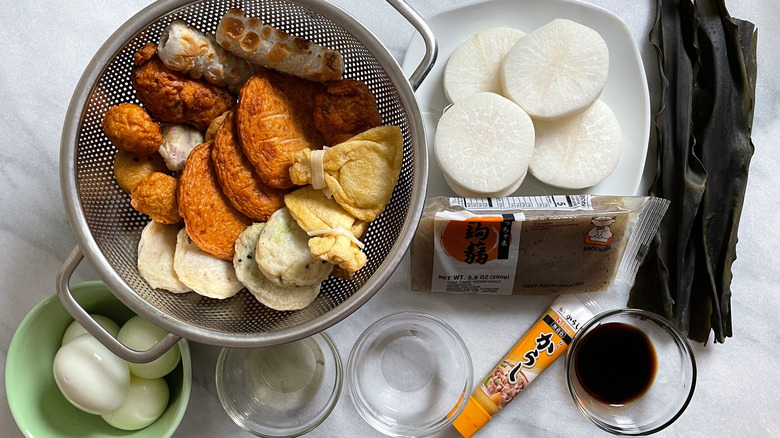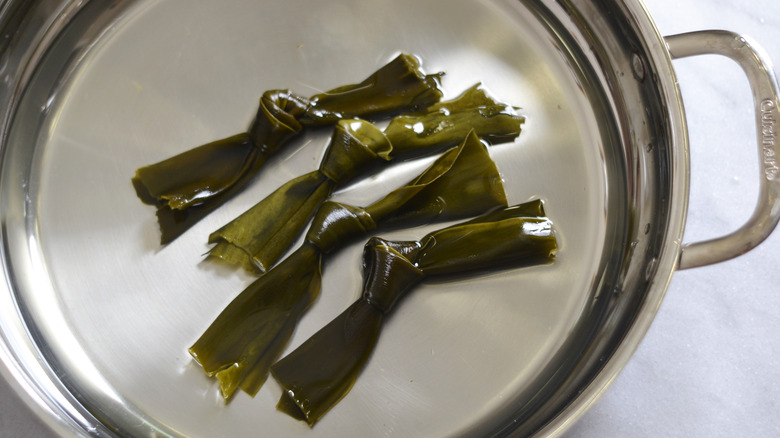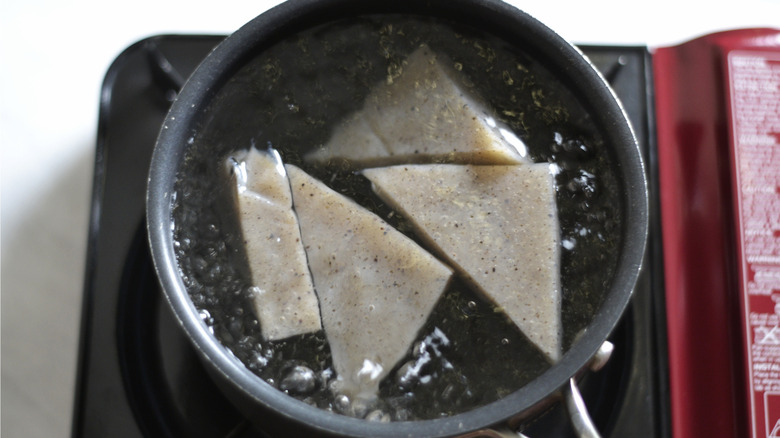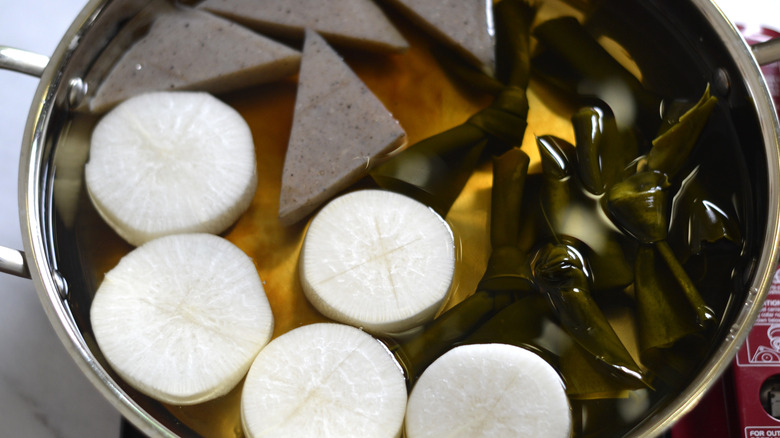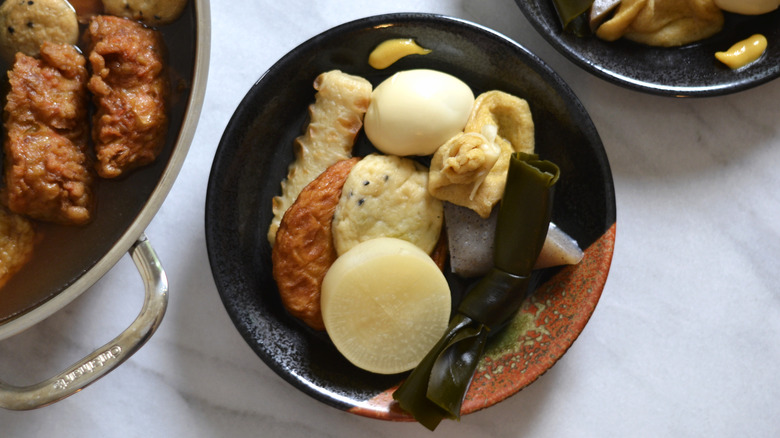Loaded Japanese Oden Recipe
Japanese cuisine probably gets the most attention worldwide for its noodle and rice dishes as ramen and sushi shops have made their way into seemingly every major city on the planet. But Japan's culinary footprint extends far beyond sushi, and oden — a massive, super-loaded fish cake stew – is just one example of Japanese cuisine that deserves more attention. This medley of fish cakes, eggs, daikon, and other Japanese flavors brings an unforgettable taste to a gut-filling amount of food.
While perhaps some eaters aren't familiar with Japanese oden, recipe developer Rika Hoffman lays it all out for us. Using Hoffman's quick recipe, you can enjoy some oden yourself in less than an hour and a half. The key here is the type of kombu or kelp used; specifically, you'll need nishime kombu.
"Some types of kombu are only used to make dashi, but nishime kombu is a special type of kombu that can be simmered and eaten," explains Hoffman. "It has a softer texture that makes it more pleasant to eat than other types of dried kelp, which are used solely for infusing soup stocks."
Gathering your loaded Japanese oden ingredients
This is an authentically Japanese meal so you might have to order some of these ingredients online if you don't have an Asian foods specialty store near you. Specifically, you'll want to order a bag of nishime kombu strips (at least six strips), a 9-ounce pack of konjac or konnyaku (a type of gelatinous yam cake), and some karashi or Japanese mustard for serving.
You need an oden set unless you have your own preference of Japanese fish cakes, and you can order this online if you can't find it near your home. You might even be able to make your own if you feel adventurous.
Oden sets are beginner-friendly introductions to the world of nerimono (that is fish cakes made with surimi or fish paste). They provide a wide variety of ingredients, including tofu products. If the oden set doesn't include all of your favorite fish cakes, you can always purchase additional ingredients separately.
Regarding the set Hoffman used that is shown in the above photo, "This 22.92-ounce oden set includes 10 kinds of fish cakes and tofu products (21 pieces in total), and a soup packet." Hoffman adds, "I omitted the soup packet from this recipe in favor of a homemade broth."
Most of the rest of the ingredients you should be able to find at any market. Get a 6-inch section of daikon (the long white radish) and some eggs. You could also probably find some of these next ingredients around your house but if not, get a small bottle of sake, a small bottle of mirin, and some soy sauce.
It's kombu time
Kombu is a delicious little sea vegetable that's packed with nutrients and ready to add a taste of the ocean to any meal. To prepare the kombu, rinse six strips of kombu briefly with running water.
"Clean the kombu with a damp paper towel or cloth, or very quickly under running water for just a second," suggests Hoffman, explaining that, "You don't want to wipe or rinse away all of the umami glutamates on the surface."
Then put the kombu strips in a pot and pour over 2 cups of water, letting the kombu soak for about 15 minutes. This rehydration should make the kombu expand and become pliable enough to tie into a knot. To do so, fold each kombu piece in half a few times (to make it thin enough to work with) and tie a simple knot.
"Besides giving a nicer presentation, the knot makes it easier to pick up with chopsticks and eat," explains Hoffman. Keep the water your kombu had soaked in for later use as the soup base, also called kombu dashi.
Konnyaku and daikon
Drain the konnyaku from its pack and pierce it with a fork to let flavor in. Then cut the konnyaku into four triangles that you'll drop into a pot of boiling water to remove the fishy kelp smell. If you haven't already prepped your daikon, slice it into ¾-inch-thick peeled rounds.
"There are two options for peeling the daikon," explains Hoffman. "Either slice the daikon into rounds and peel around the circumference with a knife, or peel the whole daikon with a vegetable peeler before slicing it into rounds. As the skin of daikon is quite tough and fibrous, it is best to remove at least ⅛ inch of the daikon skin."
However you do it, once sliced and peeled, cut shallow crosses into each side of the daikon rounds. Once the konnyaku is done remove it from the pot and set it aside with the daikon.
Bring some heat to your oden
Combine the kombu, konnyaku, and the daikon with 2 cups of the reserved kombu dashi, 3 cups of water, 4 tablespoons of soy sauce, 2 tablespoons of sake, and 4 tablespoons of mirin in a large pot. Simmer it for about 30 minutes. While simmering, get your fish cakes and rinse these with boiling water to remove the oily film. If you bought an oden kit, you can set aside the broth packet it came with and save it for another recipe.
Finish up and dig into your oden
Throw the fish cakes and your hard-boiled eggs into the stew. Simmer for another 30 minutes on medium-low heat, being careful not to let it boil since boiling can cloud the broth. "We'll want to simmer the fish cakes for around half an hour to allow the seasonings to absorb," explains Hoffman.
Once everything has simmered, scoop your oden into shallow bowls, and serve with karashi, a Japanese mustard that goes well with a ton of Japanese dishes, for dipping.
After you've eaten your fill, package everything up into sealed containers and save the leftovers in the fridge. "Oden tastes even better after a couple of days when the flavors of the ingredients and seasonings have had a chance to mingle and develop," says Hoffman.
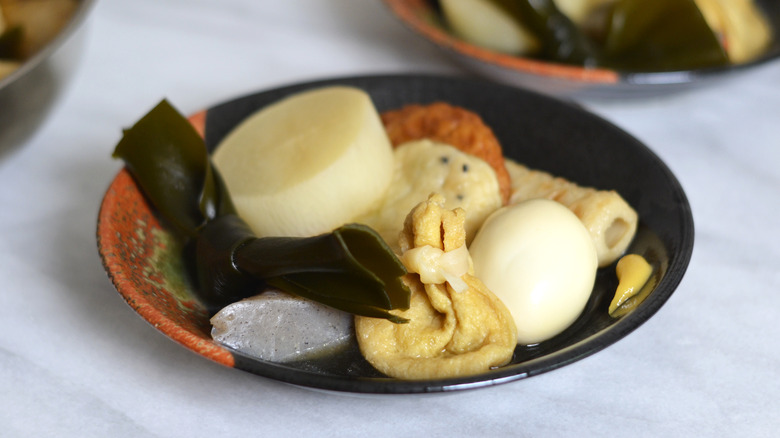
- 4–6 strips of nishime kombu
- 8–9 ounce pack of konnyaku
- 5–6-inch section of daikon
- 4 tablespoons soy sauce
- 2 tablespoons sake
- 4 tablespoons mirin
- Oden set, or your choice of fish cakes
- 4 eggs, hard-boiled
- Karashi, for serving
- To prepare the kombu, rinse each strip of kombu briefly with running water. Cover with 2 cups of water and let soak for 15 minutes. Once the kombu is soft and pliable, tie a knot in each strip. Reserve the soaking liquid; this is the kombu dashi (soup base).
- Drain the pack of konnyaku. Using a fork, pierce the konnyaku several times on each side. This will help the flavor to penetrate. Cut into four triangles. In a pot of water, boil for 2 minutes to remove the slightly fishy smell. Remove from the pot and set aside.
- Slice daikon into 3/4-inch-wide rounds. Peel the skin, and make shallow cuts in the shape of a cross on each side of the daikon rounds.
- Add knotted kombu, konnyaku, and daikon to a pot over medium heat with the 2 cups of reserved kombu dashi, 3 cups of water, soy sauce, mirin, and sake. Simmer for 25 to 30 minutes.
- Remove the fish cakes from the oden set and rinse with boiling water to remove the oily film. Set aside the packet of broth from the oden kit; we will not be using it.
- Add fish cakes and boiled eggs to the pot with the other ingredients and simmer for 30 minutes on medium-low heat. Do not allow it to boil, which can cause the broth to become cloudy.
- Once finished, scoop your oden into bowls and serve with karashi for dipping.
